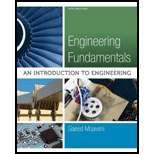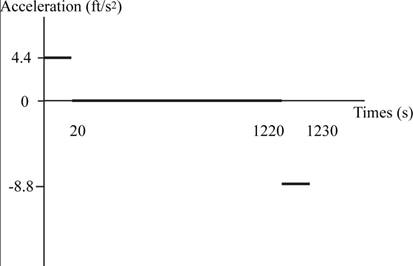
Concept explainers
Calculate the total distance traveled by the car and the average speed of the car. Plot the acceleration of car as a function of time.
Answer to Problem 28P
The total distance traveled by car is
Explanation of Solution
Refer to the figure Problem 8.28 in the textbook for the speed versus time characteristics of the car.
During the initial 20 seconds, the speed of the car increases linearly from a value of zero to 60 mph. Therefore, the average speed of the car is 30 mph during this period. The distance traveled during this period is,
During the next 20 minutes the car moves with a constant speed of 60 mph and the distance traveled during this period is,
Because the car decelerates at a constant rate from a speed of 60 mph to 0 mph, the average speed of the car during the last 10 seconds is also 30 mph, and the distance traveled during this period is,
The total distance traveled is
Substitute 880 feet for
Give the expression for average speed of the car for the entire duration of travel as below.
Substitute
To plot the acceleration of car as a function of time, calculate the acceleration during the first 20 seconds, the next 20 minutes, and the last 10 seconds.
Calculate the acceleration of the car during the initial 20 seconds as below.
Note during this 20 seconds period, the speed of car changes from 0 to
During the next 20 minutes, the car moves with constant speed of 60 mph. Therefore, the acceleration is zero.
Show the plot of acceleration versus time as in Figure 1.

Conclusion:
Thus, the total distance traveled by car is
Want to see more full solutions like this?
Chapter 8 Solutions
Engineering Fundamentals: An Introduction to Engineering (MindTap Course List)
- The figure shown a motor pulling an object in an inclined surface. Determine the power required to move the object at a constant speed of 3.5 m/s. The coefficient of friction between the object and the inclined surface is 0-20arrow_forward1. From a speed of 90 kph, a car accelerates at the rate of 10m/min/sec along a straight road . At the end of 30 seconds. What is the final velocity of the car in m/sec? 2. Determine the distancearrow_forwardIn the figure below, if the motor turns gear A with an angular acceleration of 82 rad/s2. The angular velocity of gear D isarrow_forward
- A light train made up of two cars is traveling at a speed of (90 + a) km/h where a =7 when the brakes are applied to both cars. Knowing that car A has a mass of 25000 kg and car B has a mass of 20000 kg, and that the braking force is 30 kN on each car, as shown in Figure Q1 (a). Determine the distance travelled by the train before it comes to a stoparrow_forwardA particle is constrained to travel along the path. If x = (4t^4) m, where t is in seconds, determine the magnitude of the particle’s velocity and acceleration when t = 0.5 s.arrow_forwardThe equation governing a body travelling in a water channel is given by the following equation and Plot the velocity time graph for the object and determine the final velocity and the time taken toreach this velocityarrow_forward
- The acceleration of a particle moving along the x-axis at time t is given by a(t) = 4t - 12. If the velocity is 10 when t=0 and the positive is 4 when t=0, then the particle is changing direction at t=?arrow_forward! Use the Given Data in Solving ! Rectilinear Motion: A particle travels in v = (12 - 3t^2) m/s, where t is in seconds. When t = 1 s, the particle is located 32.8 ft to the left of the origin. Determine the displacement (m) from t = 0 t = 10 s, and the distance (m) the particle travels during this time period.arrow_forwardGiven the figure below a. Find the acceleration of Wedge A. b. Compute the distance that wedge B moves after 2 seconds starting from restarrow_forward
- The acceleration record shown was obtained during the speed trials of a sports car. Knowing that the car starts from rest, determine by approximate means (a) the velocity of the car at t= 8 s, (b) the distance the car has traveled at t= 20 s.arrow_forwardFind how far an airplane will move in landing, if in t seconds after touching the ground its speed in feet per second is given by the equation. v= 180 – 18t. (hint: take v=0, C=0 ).arrow_forwardStarting from rest, a particle moving in a straight line has an acceleration of a = (2t — 6) m/s2 where t is in seconds. What is the particle's position when t = 11 s?arrow_forward
 Engineering Fundamentals: An Introduction to Engi...Civil EngineeringISBN:9781305084766Author:Saeed MoaveniPublisher:Cengage Learning
Engineering Fundamentals: An Introduction to Engi...Civil EngineeringISBN:9781305084766Author:Saeed MoaveniPublisher:Cengage Learning
